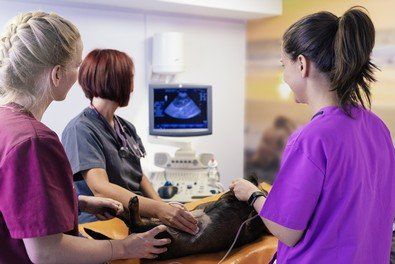Ultrasound
Ultrasound
As a practice, one of our goals is to offer state-of-the-art medicine and diagnostic testing; so we are pleased that Dr. Dinah Flack
has pursued additional training in ultrasonography
in order to help us provide a higher level of quality care
to our patients.
Dr. Flack performs ultrasounds by appointment, typically on Wednesdays. We will set up a drop-off time for your pet to stay for the day for this test. You should withhold food after 11pm the night before the ultrasound, but your pet can always have access to water. While the ultrasound itself is not invasive and not painful, your pet may require some sedation in order to stay calm and still during the procedure. Occasionally, Dr. Flack will recommend taking samples with a very small needle for analysis to look for specific types cells. Please feel free to discuss this procedure with us if you have any questions.
Ultrasonography is a type of diagnostic technique that uses ultrasound waves to produce an imaging study. This means that when we perform ultrasonography, we can see internal images of the patient’s body. Unlike some other imaging studies, like x-rays, ultrasonography does not use radiation. Instead, ultrasonography uses high-frequency sound (ultrasound) waves to create a picture of what is inside your pet’s body. Ultrasonography is a completely non-invasive, painless way to diagnose and evaluate many common diseases.
An ultrasound machine generates ultrasound waves. The machine is connected to a small probe that is held gently against your pet’s skin. The probe sends out painless ultrasound waves that bounce off of structures (for example, organs) in your pet’s body and return to a sensor inside the ultrasound machine. The ultrasound equipment collects these reflected “echoes” and uses them to generate images that are viewable on a screen. Ultrasound waves can generate excellent images of abdominal organs, including the liver, spleen, gallbladder, and kidneys. It is also useful for assessing fetal health and monitoring pregnancy in breeding animals, and it can help us diagnose and stage (determine the severity of) some forms of cancer.
CONTACT INFORMATION
Phone: (856) 478-6500
Fax: (856) 478-4119
Email: rvah@comcast.net
Address: 301 Bridgeton Pike Mullica Hill, NJ 08062
Hours of Operation:
- Saturday
- -
- Sunday
- Closed
- Mon - Fri
- -







CONTACT FORM
BROWSE OUR WEBSITE
CONTACT FORM
CONTACT INFORMATION
Hours of Operation:
- Mon - Fri
- -
- Saturday
- -
- Sunday
- Closed







Content, including images, displayed on this website is protected by copyright laws. Downloading, republication, retransmission or reproduction of content on this website is strictly prohibited. Terms of Use
| Privacy Policy
